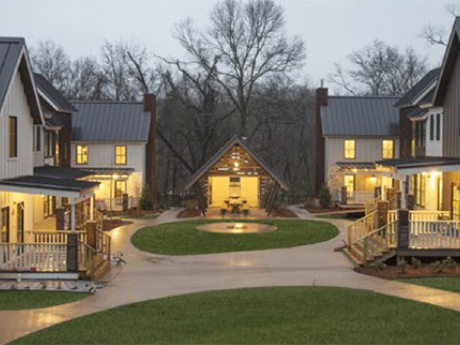By Miles Alexander
Alexander Goshen

Traditional, large-scale urban developments have failed to create vibrant, sustainable neighborhoods. Pocket communities represent a transformative approach that addresses those fundamental shortcomings through innovative public-private partnerships and financing mechanisms.
Small-scale developments of eight to 12 homes clustered around shared common spaces are experiencing significant growth as municipalities, developers and investors recognize their superior capacity to foster community connection, financial viability and environmental sustainability.
What Are Pocket Communities?
Pocket neighborhoods are clustered groups of smaller residences gathered around a shared open space, such as a garden courtyard, pedestrian street or community green. Architect Ross Chapin coined the term in the 1990s when he partnered with developer Jim Soules to create the Third Street Cottages on Whidbey Island, Washington. Built on four single-family lots totaling 28,800 square feet, the eight cottages, all less than 1,000 square feet, achieved a 100 percent density increase while creating shared amenities impossible in conventional development.
A model for other projects, the Third Street residences were laid out so that the open side of one house faced the closed side of the next, ensuring neighbors did not peer into one another’s homes while sharing spaces. Upon completion in 1998, the homes quickly sold out.
Fourteen years later, Cottages on Greene in East Greenwich, Rhode Island, achieved 16.8 units per acre when completed while appearing to consist entirely of single-family homes through innovative architectural design. The development’s success in an upscale neighborhood demonstrated that pocket communities can gain public support by maintaining a neighborhood’s character while increasing housing diversity.
Why Pocket Communities Are Becoming Popular
Traditional urban planning has demonstrated significant shortcomings that pocket communities directly address. Conventional development prioritizes cars over people, lacks adequate public spaces, makes inefficient use of land and often results in cities that lack diversity and sustainability.
Large-scale urban renewal projects have had a history of displacing residents, destroying neighborhoods through highway construction, and creating suburban-oriented developments that fragment communities rather than strengthen them.
Pocket communities are gaining popularity because they foster relationships through shared commons where residents naturally encounter one another. That leads to stronger social connections and a greater sense of belonging. Parents of young families like them because they offer protected, traffic-free environments where they can watch their children play.
The smaller footprint of a pocket community home, typically 250 to 500 square feet compared with the 2,400-square-foot average American home, reduces energy consumption, water usage and waste generation. Sustainable practices are often integrated into the design, including passive house standards, structural insulated panels and soft-engineered stormwater management through bioswales and rain gardens rather than expensive underground drainage systems.
Local governments have gotten on board, adopting zoning ordinances that incentivize pocket neighborhood development. Some cities are loosening regulations to allow more infill development on underutilized land. The 1915 Pine Street Cottages in Seattle, which were rehabilitated in 1990, inspired the adoption of new single-family land-use codes. In November 2024, the Ames, Iowa, city council considered an overlay district that would enable pocket neighborhoods in targeted areas.
Pocket Communities Create PPP Opportunities
Developers like pocket homes because of their lower construction costs, efficient use of materials, shared parking areas and reduced infrastructure requirements. The University of Arkansas Community Design Center’s rural pocket neighborhood project eliminated underground drainage infrastructure, reducing street costs by 40 percent.
The project included a public-private partnership. A U.S. Forest Service Innovation in Wood grant showed how multiple public policy goals, including local economic development, sustainable construction practices and energy efficiency, could be combined into one policy and financial package.
Cities are forming strategic alliances with private developers to transform underutilized publicly owned real estate into pocket communities. For the award-winning Heart of Boynton Village project in Florida, a public-private partnership leveraged publicly owned land and development incentives to encourage private redevelopment of a historically significant African American commercial corridor.
Maquoketa State Bank in Iowa partnered with East Central Development Corp., using a $200,000 Federal Home Loan Bank Affordable Housing Program grant and other funding sources to create a pocket home neighborhood. Ten three-bedroom houses that moderate-income families could afford were around a shared courtyard.
Community Development Financial Institutions lend to developments that traditional banks often cannot accommodate. Those lenders can fund acquisition, construction, predevelopment and permanent financing. Reinvestment Fund partnered with Atlanta Neighborhood Development Partnership to finance a demonstration project by Backyard ATL that would preserve and expand affordable housing in South Atlanta.
The Low-Income Housing Tax Credit (LIHTC) program can support pocket communities that incorporate affordable and market-rate units within single developments. Parkview Gardens in Miami’s Liberty City used LIHTC financing to transform a vacant lot in a historically disadvantaged area into garden-style apartments with community centers and playgrounds.
Projects located in Qualified Census Tracts, where at least half of the households are LIHTC-eligible, receive 30 percent higher tax credits, creating strong incentives for pocket community development in underserved areas. This bonus generates significantly more LIHTC units in census tracts just above the eligibility threshold, enabling developers to create financially viable projects that might otherwise be impossible.
Successes dating back over 30 years demonstrate that pocket communities can meet today’s housing challenges of available land, affordability and environmental impact through innovative design. Public officials, private developers, lenders, LIHTC financing sources, grant programs and community development funds have come together to create thriving neighborhoods. They serve diverse populations while generating positive returns for public and private partners.
Their success demonstrates that effective urban redevelopment requires not larger projects, but better ones — developments that incorporate community not only as a design principle but a financial asset worth cultivating and preserving.
Miles Alexander III is principal, and managing partner of Alexander Goshen, a real estate investment firm with offices in Atlanta and Fort Lauderdale, Florida.


